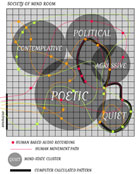.. being reminded and continuing loosely on the former post on roomology when coming across the cristalpunk workshop description and its intention to create Soft Architecture as a home grown architectonic freak show. In this intention to make sense from the surplus of automated data production an ongoing workshop was created around the Crystalpunk manifesto. Some excerpt:
On-screen and off-screen, in physical matter and in neural matter: crystals operate as synaptic agents of self-organised control, remixing pre-existing fragments of the world; if you can see them, they are successful.
False memories can be replaced by genuine ones, separate realms of reality can be flattened and brought to uniform size and blended into one whole presupposed by its parts.
Current thoughts accompanying this process and translations of the programmatic approach into ‘space’ can be found at the worksop website.
| Every room has an accessible history, every place has emotional attachments you can open and save”. New technologies can associate places with layers of free and editable content from which the past can be re-enacted, like a murder at the scene of the crime is re-enacted, to re-experience and stir vanished memories. Little minds living in software can eat any piece of data, extract meaning from it and email it to you when the right criteria has been met. … |
 |
What the Elephant Man is to the Athletic Body, the Crystalpunk Room will be to the Smart House
… Buildings learn, rooms have memories, design does not need its designers, the language of time (piecemeal extensions, reinventions, rephrasings, accidents, entropy) rewrites their script. A room, by implication, refuses to be belittled into the function of a radio, it wants to be a broadcaster too. Continuous sending information to the world, a room can have a virtual identity and under this guise live a secret life. For instance: a crystalpunk moves his leg for comfort, a crystalpunk shakes her head in disagreement, sensors pick up on it, triggering a wide range of reactions known and unknown, local and faraway. To paraphrase Ezra Pound: in soft architecture each gesture creates content that has form as water poured into a vase has form. Content is recyclable, routed multiple times, finally ending up back where it initiated: causing a sound closing a door illuminating a cryxal on-screen. A crystalpunk walks through the room and, like in a crappy disco, the floor lights up underneath her feet, too bad he is not feeling very much like a dancing queen tonight. …


